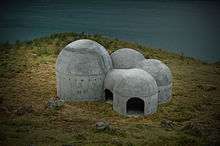Lukas Kühne
Lukas Kühne is a German sound sculptor.[1] His best-known works consist of resonating concrete chambers that are tuned to react to certain pitches.[2] Kühne's site-specific sculptures stand in public spaces in Estonia, Finland, Iceland, Germany and Uruguay.
Lukas Kühne | |
|---|---|
| Nationality | German |
| Known for | Sound sculpture |
| Movement | |
| Website | www |
Artistic career
Between 1999 and 2001, Kühne created the "sound station", one of the seven "sense stations" in the park of the senses in Weissensee, Berlin.[3]
Kühne developed the Space and Frequency project with Robyn Schulkowsky in 2005, with monumental and interdisciplinary exhibitions in New York City, Helsinki and Brussels. He curated several exhibitions of sound art, such as Espacio y Frecuencia in the National Museum of Visual Arts (MNAV) and Rumbo al Ruido in the MAPI Museum for Pre-Columbian Art, both in Montevideo, Uruguay.[4][5][6]
He created Cromatico, a permanent sound sculpture on Tallinn's Sound Festival Grounds, for the Tuned City Tallinn event in 2011. Cromatico is tuned to the F chromatic scale, with each of the 12 chambers corresponding to a pitch along the scale from 88 Hz (F) to 164 Hz (E).[7][8] It won the Grand Prix of the Concrete Building of the Year competition by Estonian Concrete Association in 2011.[9] His other contribution to the soundscape of Tallinn was the idea to use the historic Seaplane Harbour hangar, a pre-modernist concrete structure, as a "sonic landmark". The hangar became one of the pieces of "aural architecture" where artists experimented and worked during Tuned City Tallinn 2011.[10]

Tvísöngur, opened in 2012, consists of five interconnected concrete domes on the hillside above Seyðisfjörður in east Iceland. It is a tribute to the Icelandic cultural heritage of polyphonic duets, or "twin-singing". The five domes, reaching a height between 2 and 4 meters, amplify and resonate with the tones of consecutive fifths, which form the basic structure of the musical form. The sculpture is accessible to visitors, who can experiment with the sounds. The choice of building material is also related to Iceland, which has a tradition of monumental concrete buildings such as Hallgrímskirkja. Two years later, Kühne built a similar installation, the Hailuoto Organum, in Finland.[11][12][13][1]
Together with a working group of 8 Aalto University postgraduate students, Kühne created a virtual, playable version of the Sibelius Monument inside Ateneum, the National Gallery of Finland in Helsinki, as part of a larger exhibit honouring Jean Sibelius' jubilee year. The piece was later presented at ISEA 2015 in Vancouver, Canada.[14]
Kühne founded the Experimental Format of Form and Sound (Taller Experimental Forma y Sonido) in 2005 and the International Festival of Sound Art Monteaudio (Festival Internacional de Arte Sonoro Monteaudio) in 2013, both at the University of the Republic in Montevideo.[15] One of his works is on permanent display in the city: tubófono, a musical instrument located in Parque Rodó.[16]
He lives in Berlin and Montevideo.[12]
Major works
External links
References
- "New Sound Sculpture Opens in East Fjords". Iceland Review. 5 September 2012. Retrieved 27 March 2017.
- Hannes Einpaul (2014). "Resonating spaces and room acoustics" (PDF). Listahaskoli Íslands. Retrieved 27 March 2017.
- Viola Volland (9 October 2002). "Sinnfindung" (in German). Der Tagesspiegel. Retrieved 30 March 2017.
- "Lukas Kühne" (in Spanish). Seminario Artes Mediales. Retrieved 27 March 2017.
- "Space and Frequency Rhythm Lab" (PDF). Space and Frequency. 8 June 2005. Retrieved 27 March 2017.
- "Rumbo al Ruido @ Mapi" (in Spanish). Relacionamiento Urm-Ienba. 16 October 2007. Retrieved 30 March 2017.
- Shea Trahan. "Precedent Exercise" (PDF). The Resonance Center. Retrieved 28 March 2017.
- "'Cromatico' sound sculpture". Visit Estonia. Retrieved 28 March 2017.
- "The competition „Estonian Concrete Building of the Year 2016" begins". TMB Element. 27 September 2016. Retrieved 28 March 2017.
- John Grzinich. "Sea plane hangar of Tallinn, anatomy of an acoustic space". Maaheli. Retrieved 27 March 2017.
- "Hailuoto Organum". Hailuoto. Retrieved 27 March 2017.
- Christina Lorenzen. "Klangsinstallation in Ost-Island" (in German). Goethe Institut Dänemark. Retrieved 27 March 2017.
- "Tvísöngur – Klangkulisse am Rande des Fjords" (in German). Zauber des Nordens. 20 February 2016. Retrieved 27 March 2017.
- Ava Grayson. "Passio Musicae Open Source". Retrieved 28 March 2017.
- "Lukas Kühne: "Mi territorio es acústica pura"" (in Spanish). Artishock. 2 December 2015. Retrieved 27 March 2017.
- "La Rambla: treinta kilómetros de historias" (in Spanish). El Observador. 8 February 2017. Retrieved 28 March 2017.